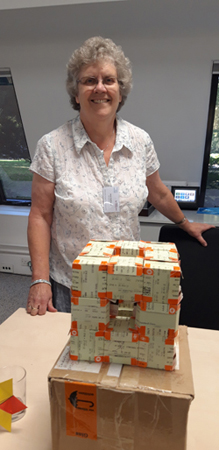Exploring Shape and Space Practically
Maths Scholars Celebratory Event - 21st September 2019
.jpg)
1 envelope, 2 sheets of A4 paper and 6 train tickets. From this simple set of objects, Anne Fieldhouse showed that a vast array of concepts can be explored along the way to constructing some beautiful and surprising mathematical objects. Furthermore, important pedagogical issues such as behaviour management, questioning techniques, learner ability and common misconceptions were discussed.
First up the envelope. Anne explained how it is important not to over estimate ability with concepts and skills that may be perceived by some to be easy or obvious. The first folds demonstrated Anne’s words of caution – some Scholars deftly folded crisp lines in perfect alignment, whilst others, well not so much. (I am not ashamed to say I was in the latter group as it seemed I had over indulged in the coffee and had a less than steady hand!) At each stage of the construction Anne guided us through the range of topics that could be covered – shape properties, fractions and angles to name a few – as well as sharing how best to present the folding construction to students. Throughout, she interwove advice on making sure that teacher questions and student answers were explicit and accurate. “What shape have we made now?”, “How can you prove this?”, “Is it enough to say that a rectangle has four sides?” As we progressed, the excitement built. Once the construction was completed there were smiles, laughter, surprise and intrigue all around the room. Anne went on to explain how the final 3D model could be used to build spatial reasoning and address misconceptions about 2D representations of 3D objects as the students would be able to move and view the objects for themselves.
 Next it was the turn of the 2 sheets of paper to be transformed into Christmas Stars /Easter Flowers – a good resource should always be adaptable! The construction began in the same way; we were advised that repetition developed and reinforced pathways in the brain, but this did not mean that exactly the same question or task needed to be repeated for this to happen. At each stage a wealth of opportunities to branch out across a number of domains became available, from demonstrating what a tangent is, to discussing error bounds when making objects. Anne explained that for many pupils being able to see and feel the mathematics led to a much deeper understanding of the concepts. The final object was very pleasing aesthetically, and no doubt students would be keen to share their knowledge with others.
Next it was the turn of the 2 sheets of paper to be transformed into Christmas Stars /Easter Flowers – a good resource should always be adaptable! The construction began in the same way; we were advised that repetition developed and reinforced pathways in the brain, but this did not mean that exactly the same question or task needed to be repeated for this to happen. At each stage a wealth of opportunities to branch out across a number of domains became available, from demonstrating what a tangent is, to discussing error bounds when making objects. Anne explained that for many pupils being able to see and feel the mathematics led to a much deeper understanding of the concepts. The final object was very pleasing aesthetically, and no doubt students would be keen to share their knowledge with others.
Last, but by no means least, the six train tickets were to be metamorphosed into a regular 3D polyhedron. When it came to slotting the modules together, much to the amusement of the Alumni member on my table, my coffee-soaked brain struggled to work out what to do. After some perseverance it clicked, and I was rewarded with a sense of satisfaction at completing the model. Finally, Anne demonstrated the possibilities that could be created by slotting the models together. Just like for the first construction, these models could be used to build links between 2D and 3D representations – repetition does not have to mean replication.
This session to me was mathematics at its best – engaging, challenging, far reaching and rewarding. I can’t wait to show my students the beautiful mathematics hiding in 1 envelope, 2 A4 sheets of paper and 6 train tickets.
By Mark Jeffreys
Image provided by author